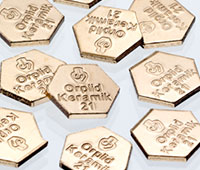
Orplid Keramik 21
Type 4**
yellow / Au 86.0
palladium-free, silver-free, copper-free
| Composition: | Au 86.0 / Pt 11.4 / In 0.9 / Rh 0.9 / Ta 0.4 / Mn 0.2 / Ir 0.1 / Ge 0.1 |
| Standard: | DIN EN ISO 22674 and DIN EN ISO 9693 |
| Colour: | yellow |
| Melting range °C: | 1130–1080 |
| Soft annealing: | 15 mins at 700 °C/ quench in water |
| Hardening: | 15 mins at 500 °C/ air |
| Preheating temperature °C: | 850 |
| Casting temperature °C: | 1280 |
| Further heating after melting (secs): | electr.: 60–90 inductive: 5–10 flame: 5–10 |
| Density g/cm3: | 19.0 |
| CTE 25°C–500°C (µm/mK): | 13.8 |
| CTE 25°C–600°C (µm/mK): | 14.1 |
| Soldering before firing: | Orplid Ceramic solder 1020 |
| Soldering after firing: | Orplid solders 825, 735 |
| Vickers hardness (HV 5/30): | w: 100 a: 170 g/b: 130/150 |
| 0.2% proof stress (MPa): | w: 200 a: 400 g/b: 280/340 |
| Elongation at break (%): | w: 23 a: 15 g/b: 16/17 |
| Spruing: | Following the rules for dental applications (see General Instructions for Use) |
| Investment: | Phosphate-bonded investment materials |
| Preheating: | 850 °C, 30 to 120 mins until end temperature, depending on size of mould |
| Casting: | 1280 °C, possibly increase by 20°C–30°C for resistance-heated vacuum pressure casting. Graphite crucible or open flame with ceramic crucible. |
| Finishing: | With carbide burs and/or ceramic-bonded stones. Always grind in one direction only! Sandblasting at a flat angle, using 110–125 µm aluminium oxide. Pressure should not exceed 2 bar |
| Cleaning: | Steam jet cleaning or boiling in distilled water |
| Oxide firing: | 5 mins at 900°C without vacuum |
| Soldering before firing: | Orplid Ceramic solder 1020 |
| Soldering after firing: | Orplid solder 825; Orplid solder 735 |
| Firing: | For normally expanding ceramic materials |
